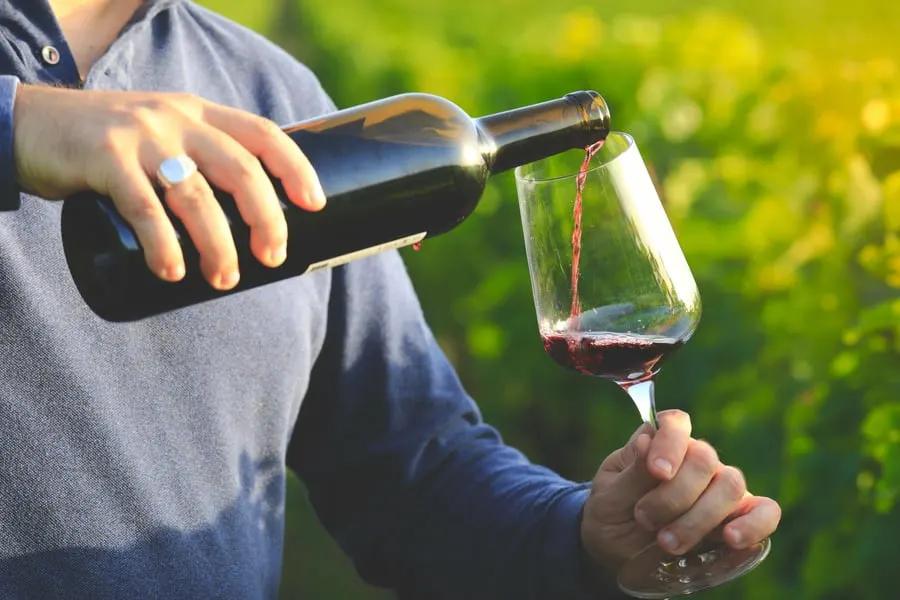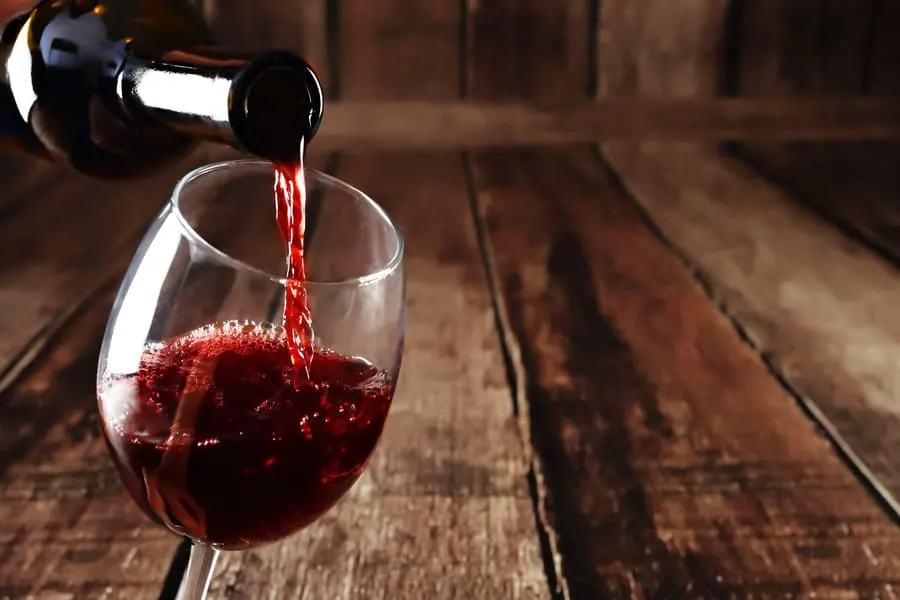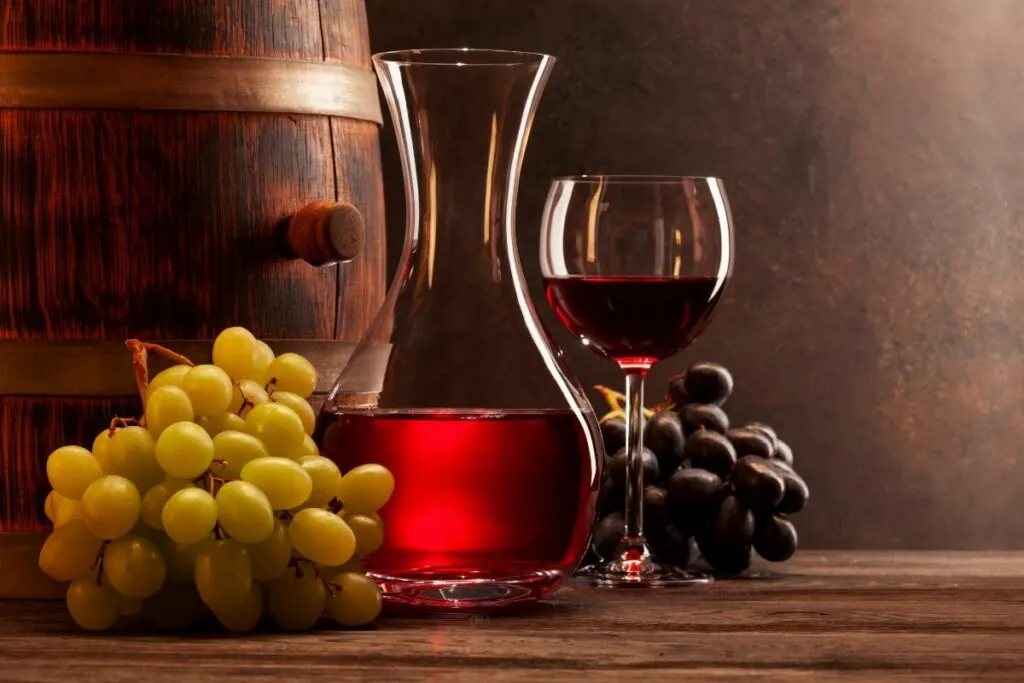As an Amazon Associate, I earn from qualifying purchases with no additional costs for you.
Pouring a beautiful red into a glass is sure to get everyone’s mouth-watering. But there are a ton of misconceptions around the best temperature to serve this category of wine. A ton of people believe room temperature is the ideal serving temperature but that needs correction.
Should red wine be served at room temperature? It is a common misconception that red wine should be served at room temperature which is between 68°-72°F. Depending on the grape varietal, red wine should generally be served slightly cooler, between 64°-68°F.
Please read on for a complete breakdown of the proper serving temperature for red wine written by a true wine professional with years of experience.

TIP: If you want to check out the best refrigerator for wine storage, I recommend trying out the Avation (18 bottles) compressor refrigerator with Wi-fi smart app control cooling system. You can find this refrigerator by clicking here (Amazon link).
Ideal Red Wine Serving Temperature
So How is Red Wine Best Served?
The first thing to look at is the alcohol percentage. Wines with a higher ABV (Alcohol by Volume), ranging between 16%-20%, should be served closer to 64°F.
The reason being is the cooler temperature will mask some of that alcohol, allowing the primary aromas to shine through. This also allows you to experience those complex, hidden layers of flavor that could be easily overpowered by said alcohol.
Red wines with a 13%-15% ABV can be served at a slightly higher temperature of about 68°F. If this wine is too cold, the delicate bouquet of notes and flavors could be muted. Your wine should be an open book, just waiting to be read.
TIP: A suitable wine glass is the basis for enjoying well-being while drinking your favorite wine variety. Here are our favorite ones (Amazon link):
- Bormioli Rocco Crystal Wine Glasses: A set of eight elegant and traditional wine glasses made in Italy for a reasonable price.
- Riedel VINUM Wine Glasses: Luxury set of two wine glasses suitable for any occasion. We just love them!
- Schott Zwiesel Tritan Crystal Glasses: If you like unusual alternatives, a set of six stemless glasses made of crystal glass.
The next thing to consider is tannins, a.k.a. the “body”. Contrary to what occurs with alcohol, the colder the wine, the more the tannins come out to play. Wines that have a heavier tannic structure can be overpowering and quite dry on the tongue if served too chilled.
The oak also becomes more amplified, ultimately making the profile of fruitless present. Typically, these wines should be served at the higher end of our temperature scale, around 68°F.
As for lighter wines, such as a Beaujolais, these should be served slightly cooler, at about 64°F. The fine tannic structure is not as straightforward on the palate, as will be in a spicy Malbec, per se.
This lower temperature will accentuate the tannins, showcasing their texture. A warmer temperature tends to make the delicate tannins taste flat. If you have yet to invest in a wine fridge or wine cellar, try popping your next bottle of red into the freezer for 10-15 minutes before serving. This is a quick way to get that ideal temperature.
TIP: For a list of great wine refrigerators that cost less than $300, check out this article. These wine coolers are all top-rated and built by great companies. Why would a wine refrigerator stop working? This article lists a few of the most common problems and repair estimates.
Suggested Serving Temperatures for Specific Red Wines
Whether you love the big bold reds, or prefer the light and playful ones, understanding the tannin levels is essential to enjoying the wines at the exact temperature as they were intended. Here are some general guidelines when it comes down to specific varieties.
Heavier Bodied Red Varietals; Cabernet Sauvignon, Nebbiolo, Tempranillo, Bordeaux Blends, Petit Verdot, Malbec, Petit Syrah, GSM or Rhone Blends and Syrah or better known to the Aussies as ‘Shiraz’. These wines should be served between 65°- 68°F, depending on the alcohol content.
Lighter to Medium Bodied Red Varietals; Pinot Noir, Gamay, Montepulciano, Sangiovese, Merlot, Grenache, Cabernet Franc, and Zinfandel. These wines should be served slightly cooler, around 64°F.
In some cases, reds can have a substantial amount of alcohol and tannins, creating a deep, heavy-bodied red gem (just look at some of those Italian and Spanish reds). What to do in these situations?
Meet the high alcohol and high tannin in the middle, serving around 65°- 66°F. Like Goldilocks and her porridge, meeting halfway will make it juuust right.
When it comes to sweet and fortified red wines, such as ports, these should always be served nicely chilled, at approximately 60°F-62°F. If served warmer, these special wines may start to smell more like spirits, as they are typically higher in alcohol than unfortified wines (between 19% – 20%).
Cool-Climate and Warm-Climate Red Wines

Coincidentally, higher alcohol wines that taste better served at a slightly higher temperature derive from warmer climates. In many cases, a lot of those 15%-16% alcohol-rich reds such as Shiraz or Nebbiolo, thrive on sunshine. This is because they have thicker skins. In order for them to ripen nicely, they require more heat and sun exposure.
Just as well as swirling in your glass, these powerful, captivating jewels showcase their best profile around 68°, rather than 64°. Whilst grapes like Pinot Noir and Gamay have thin skin, they are much more susceptible to “raisining” from too much heat.
This is pretty much a grapes version of a nasty sunburn. Ouch. When harvesting time rolls around, grapes such as these are usually always picked before any other red variety. This is why their alcohol rarely exceeds 14%. Many times, these wines are described as elegant, fruit-driven, gentle, and fresh.
To sum it up, serve the cold-climate reds at a colder temperature, and the warm-climate reds at a higher temperature. Whether jammy or tart, robust or silky, be sure there is enough room at your table for both.
There are grapes that naturally have higher acidity than others, but the climate is also one of the main elements that influence acidity levels in wine.
The longer grapes are left on the vines to ripen, the lower the acidity levels drop, and the higher the sugar levels rise. In a perfect vintage, both of these components are perfectly balanced.
If you pop open a bottle of red, and it doesn’t quite have that mouth-watering finish in the end palate, chilling it a bit longer might be the answer.
While the chemistry of the wine remains relatively unchanged once in the bottle (with a few exceptions), cooling the wine down a few more degrees will dull some of the sweetness and alcohol, while sharpening the acidity.
This is never the ideal situation to be in, so I recommend researching how that particular vintage performed in that particular region before purchasing. It’s well worth it.
Recommendation box: Everything you need to enjoy your wine as much as possible. All recommended products are personally tested and regularly used by experts from this website (Amazon links):
> Ivation Wine Cooler – Energy-efficient wine cooler for 18 bottles with Wi-fi smart app control cooling system.
> Wine Rack – Beautiful, elegant wood rack for up to 7 bottles and the choice of vertical or horizontal storage.
> Durand Wine Opener – Classic vintage wine opener (we like all these classic staff).
> YouYah Iceberg Wine Decanter – The most beautiful and handy wine decanter we personally use.
> Bormioli Rocco Wine Glasses – A set of eight elegant and traditional wine glasses made in Italy.
> Vintorio Wine Aerator – Simple but really useful wine aerator for a reasonable price.
> The Original Vacu Vin Wine Saver – The best wine saver on the market in a package with two vacuum stoppers and two wine servers.
And if you want to become a true connoisseur of wine, we recommend reading the book Wine Folly: The Essential Guide to Wine (Amazon link), where you will find all the information you need about winemaking, wine varieties, flavors, and much more.
Best Temperature to Store Red Wine
To obtain the maximum longevity of your wines, always store bottles laying down, with the label facing up. This will allow the wine to “breathe” just enough oxygen through the pores of the cork to keep those delicious secondary aromas evolving.
TIP: Most wines go bad once you pop the cork within a day or so. But a Coravin Wine Preservation system (available for a great price on Amazon) can extend the life of your opened wine for weeks or even months. It is awesome. You should check it out to see if it fits your lifestyle.
Having easy sight of the label will avoid the risk of twisting and turning the bottle, shaking up the sediment and acid crystals that aren’t so pleasant to have in your glass.
If you plan to store your wine for an extended amount of time, be sure to keep the bottle angled at least 45 degrees when opening and decanting.
If you turn the bottle upright, all of the sediment that has been graciously resting on the side of the bottle will mix into the wine, thus defeating the purpose of decanting.
Pro tip: Get yourself a wine-decanting basket! They are very affordable and a beautiful way to display your bottle.
The French word for “cellar” is a cave. When you imagine an actual cave, do you tend to think dark, cool, and perhaps a bit damp? Fun little fact, many French wineries still use caves that were dug out to store wine and Champagne, some dating as far back to the Roman Empire.
The French were definitely correct to do so; caves are a perfect environment to store wine. However, like most of us, if you don’t have your own personal underground cave, let’s talk about a more practical way to the cellar.
TIP: To learn how to properly store red wine, follow the guidance in this thorough article reviewed by a wine professional. Does sunlight have an effect on red wine? Find out here.
The two biggest factors for keeping wine are light and temperature. Light breaks down the main chemical and molecular foundation, which can cause structural imbalance and spoilage. When it comes down to your vino, little to no light is ideal.
Generally, red wines should be stored at a temperature of about 55°F. This is cool enough to preserve the phenolic compounds, all while allowing the wine to age steadily.
Humidity is another element to take into consideration. Unless you live in an extremely dry or wet climate, don’t fret too much. While 70% is considered ideal, keeping your wine between 60%-80% humidity will do just fine.
If you do not have a wine fridge, consider spaces in your home that have conditions similar to the ones above. What about regular kitchen refrigerators? Fridges are not the best place for long-term storage, as they usually get cooler than 55°F.
They are designed to keep most moisture out so that perishable food stays fresh. Mini fridges that are only used for wine are a better option, as you can set and control the desired temperature more easily.
A basement is a good place as well, as long as it is not too damp. Too much moisture will cause the corks to mold and taint.
TIP: To learn why some wine corks mold and how to prevent it from spoiling your wine, check out this helpful article. Do you know if you can drink wine with cork in it? Read this article for the answer.
Try to find a space without direct sunlight pouring in, such as a spare closet or possibly an enclosed hutch. Considering these options, simple wine racks are a good addition to stopping your bottles from rolling around.
TIP: Having quality storage racks for your wine is not only practical but can also serve as a nice design accessory for your home. We loved these (Amazon links):
- Ferfil Wine Rack (10 Bottles): Concertina/scissor fold wooden wine rack made of solid, eco-friendly wood.
- Gusto Nostro Wood Wine Rack: Beautiful, elegant design, the possibility of storing up to 7 bottles, and the choice of vertical or horizontal storage.
At the end of the day, if spending $500-$1,000 on a cooling unit costs less than your annual wine-buying budget, you might as well preserve your investment. Your wines will thank you later. Here is an article featuring some great wine refrigerators for people on a budget.
Decanting Temperature for Red Wine Serving

With an easy 10°F difference of proper storage and serving temperature, you should always allow the wine some time to reach this point before serving. This does not necessarily mean that you need to wait for the wine to warm up before decanting, aerating, or even pouring.
As a matter of fact, the sooner the wine is out of the bottle, the quicker it will come to the ideal serving temperature because it will have more contact with the air. In a moderate climate, the time it takes for a decanted bottle to come to this correct temperature is approximately 45 minutes, or 60 minutes if not decanted.
TIP: If you are interested in buying a wine decanter, I recommend purchasing these two top-quality decanters:
- USBOQO Wine Decanter (check it out on Amazon & read customer reviews)
- Iceberg Wine Decanter (check it out on Amazon & read customer reviews)
It will come to temperature much quicker if already poured into glasses, as there is less mass volume to warm up.
Most red wines benefit from being decanted, with a few exceptions;
- Pinot Noir
- Gamay
Besides sediment separation, the other main reason why red wines are decanted is to allow the air to open up the tannins, making them softer, rounder, and more palatable. Pinot Noir and Gamay are known for being soft and lighter-bodied. This is because they are naturally lower in tannins.
- Very aged wines (50+ years)
I once attended a very special dinner in Paris hosted by Francois Audouze, one of France’s most famous vintage wine collectors. To this day, I still pinch myself thinking about the wines that were served, such as a 1959 Chateau Ausone, a bottle that leaves one awe-struck.
One thing that I immediately noticed was that none of these precious beauties were decanted. Mr. Audouze explained that wines this old are extremely delicate. They must be introduced to the oxygen slowly (hence the name Francois Audouze Method).
If the wine is overexposed to oxygen too quickly, this can cause it to give off vinegar-like notes almost immediately. This legend of wine shouldn’t be caught dead tasting anything less than fabulous.
When enjoying these special bottles, it’s a good idea to stand them upright and open 4-6 hours before serving. This will be enough time to let the sediment settle on the bottom of the bottle, while gently awakening that extraordinary wine that has been snoozing for such a long time.
In this case, how do we serve the sleeping beauty at the correct temperature? Try carefully placing the bottle in a bucket of cold water, and twist it ever so slowly for a few minutes to ensure even temperature distribution.
TIP: Can you decant wine in a bottle? This article explains all you need to know. If you don’t have a refrigerator, how do you safely store your favorite wine? Read this article to find out!
Conclusion: Red Wine & Room Temperature Serving
Although this article outlines specific temperatures that your vino should be served at, a good rule of thumb is to serve your red wines slightly below room temp. While a great tool that could help with accuracy is a wine thermometer, don’t forget to go with your intuition.
Whether you are a whizz with your knowledge of reds, or just getting to know the varieties, one thing is certain…a wine can show a completely different flavor profile and character according to its temperature…and that’s cooler than you think.
TIP: Check out this page for a complete list of wine products and accessories I love. You’ll find my recommendations for wine refrigerators, decanters, and aerators and the best place to buy wine online. Click here to see the complete listing.
